HRM: Key Challenges in Attracting and Retaining Staff - Manufacturing
VerifiedAdded on 2023/06/04
|11
|3714
|394
Essay
AI Summary
This essay delves into the critical challenges faced by the manufacturing sector in attracting and retaining talented employees. It highlights issues such as the lack of a secure working environment due to increased competition and pressure for high sales, the impact of mechanization on employee morale and job security, workplace health and safety concerns stemming from mechanized environments and increased working hours, the competition leading to reduced work-life balance, and the absence of growth opportunities and career development prospects. The essay emphasizes that while compensation is important, a conducive work environment, job security, and career development are crucial for employee retention. It further points out that the failure to address these challenges leads to higher turnover rates and decreased productivity, affecting the overall success of manufacturing organizations. The essay uses examples to illustrate these points, highlighting the importance of balancing technological advancements with employee well-being and development.

Running head: HUMAN RESOURCE MANAGEMENT
Human Resource Management
Name of the Student
Name of the University
Author note
Human Resource Management
Name of the Student
Name of the University
Author note
Paraphrase This Document
Need a fresh take? Get an instant paraphrase of this document with our AI Paraphraser
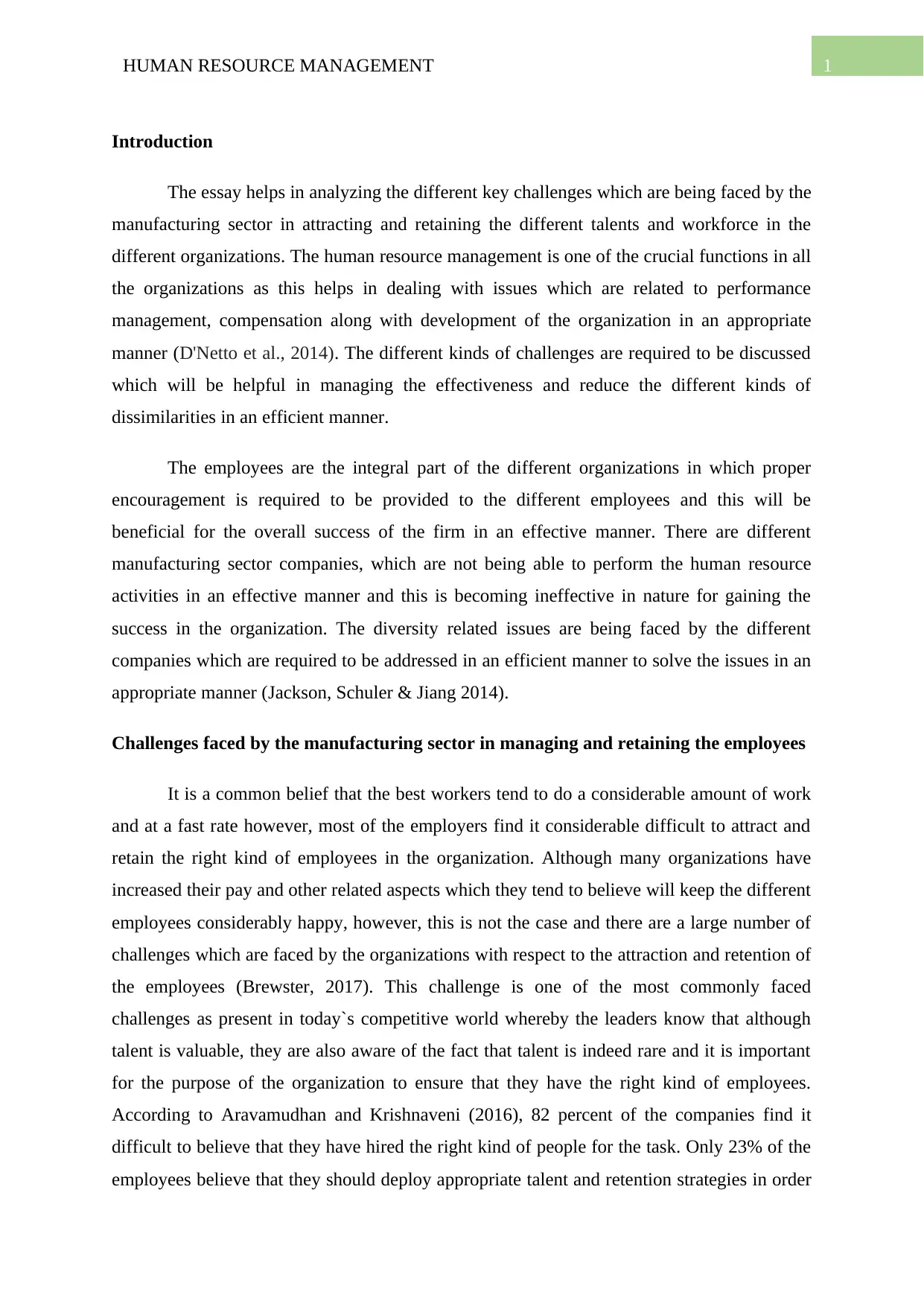
1HUMAN RESOURCE MANAGEMENT
Introduction
The essay helps in analyzing the different key challenges which are being faced by the
manufacturing sector in attracting and retaining the different talents and workforce in the
different organizations. The human resource management is one of the crucial functions in all
the organizations as this helps in dealing with issues which are related to performance
management, compensation along with development of the organization in an appropriate
manner (D'Netto et al., 2014). The different kinds of challenges are required to be discussed
which will be helpful in managing the effectiveness and reduce the different kinds of
dissimilarities in an efficient manner.
The employees are the integral part of the different organizations in which proper
encouragement is required to be provided to the different employees and this will be
beneficial for the overall success of the firm in an effective manner. There are different
manufacturing sector companies, which are not being able to perform the human resource
activities in an effective manner and this is becoming ineffective in nature for gaining the
success in the organization. The diversity related issues are being faced by the different
companies which are required to be addressed in an efficient manner to solve the issues in an
appropriate manner (Jackson, Schuler & Jiang 2014).
Challenges faced by the manufacturing sector in managing and retaining the employees
It is a common belief that the best workers tend to do a considerable amount of work
and at a fast rate however, most of the employers find it considerable difficult to attract and
retain the right kind of employees in the organization. Although many organizations have
increased their pay and other related aspects which they tend to believe will keep the different
employees considerably happy, however, this is not the case and there are a large number of
challenges which are faced by the organizations with respect to the attraction and retention of
the employees (Brewster, 2017). This challenge is one of the most commonly faced
challenges as present in today`s competitive world whereby the leaders know that although
talent is valuable, they are also aware of the fact that talent is indeed rare and it is important
for the purpose of the organization to ensure that they have the right kind of employees.
According to Aravamudhan and Krishnaveni (2016), 82 percent of the companies find it
difficult to believe that they have hired the right kind of people for the task. Only 23% of the
employees believe that they should deploy appropriate talent and retention strategies in order
Introduction
The essay helps in analyzing the different key challenges which are being faced by the
manufacturing sector in attracting and retaining the different talents and workforce in the
different organizations. The human resource management is one of the crucial functions in all
the organizations as this helps in dealing with issues which are related to performance
management, compensation along with development of the organization in an appropriate
manner (D'Netto et al., 2014). The different kinds of challenges are required to be discussed
which will be helpful in managing the effectiveness and reduce the different kinds of
dissimilarities in an efficient manner.
The employees are the integral part of the different organizations in which proper
encouragement is required to be provided to the different employees and this will be
beneficial for the overall success of the firm in an effective manner. There are different
manufacturing sector companies, which are not being able to perform the human resource
activities in an effective manner and this is becoming ineffective in nature for gaining the
success in the organization. The diversity related issues are being faced by the different
companies which are required to be addressed in an efficient manner to solve the issues in an
appropriate manner (Jackson, Schuler & Jiang 2014).
Challenges faced by the manufacturing sector in managing and retaining the employees
It is a common belief that the best workers tend to do a considerable amount of work
and at a fast rate however, most of the employers find it considerable difficult to attract and
retain the right kind of employees in the organization. Although many organizations have
increased their pay and other related aspects which they tend to believe will keep the different
employees considerably happy, however, this is not the case and there are a large number of
challenges which are faced by the organizations with respect to the attraction and retention of
the employees (Brewster, 2017). This challenge is one of the most commonly faced
challenges as present in today`s competitive world whereby the leaders know that although
talent is valuable, they are also aware of the fact that talent is indeed rare and it is important
for the purpose of the organization to ensure that they have the right kind of employees.
According to Aravamudhan and Krishnaveni (2016), 82 percent of the companies find it
difficult to believe that they have hired the right kind of people for the task. Only 23% of the
employees believe that they should deploy appropriate talent and retention strategies in order
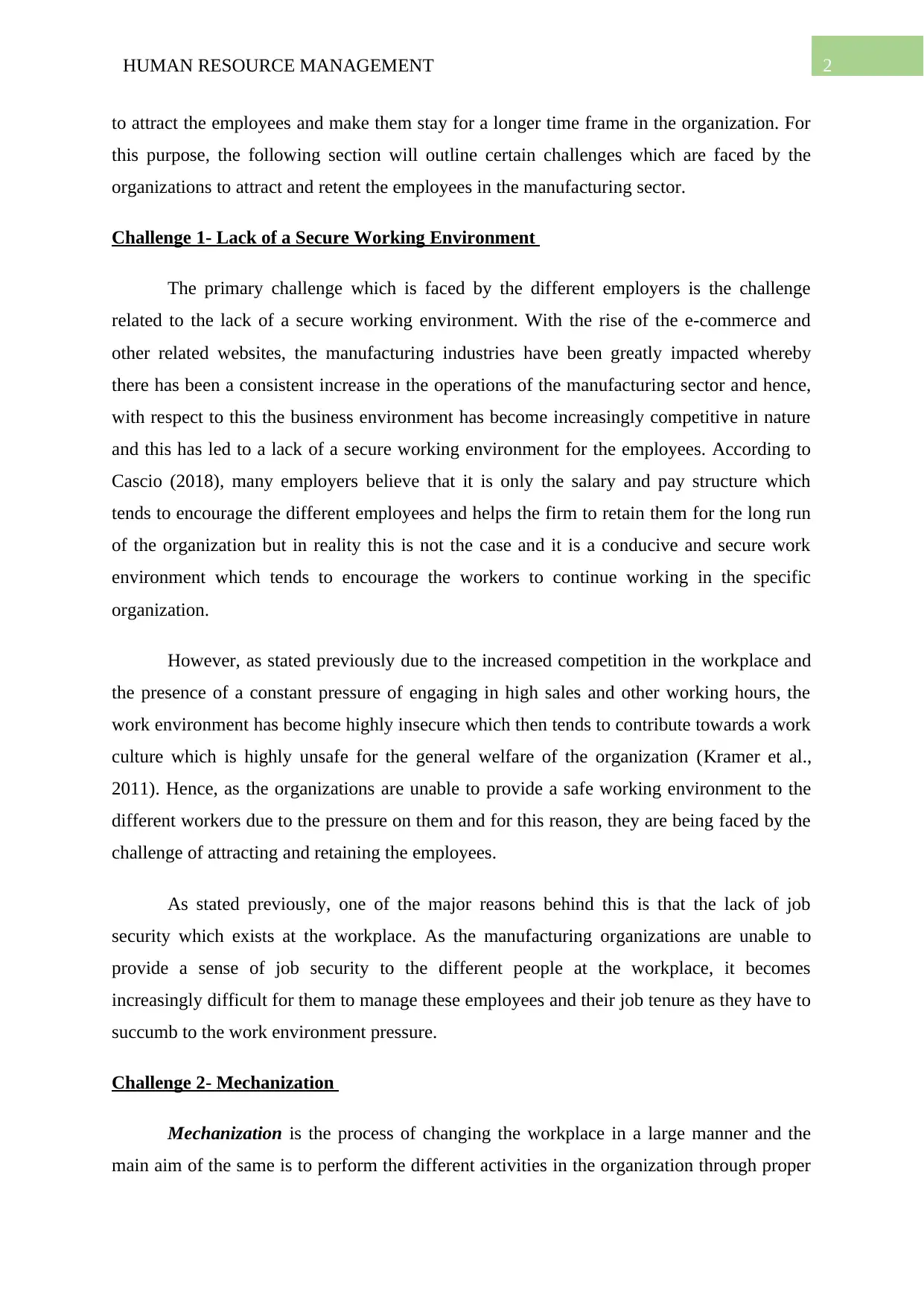
2HUMAN RESOURCE MANAGEMENT
to attract the employees and make them stay for a longer time frame in the organization. For
this purpose, the following section will outline certain challenges which are faced by the
organizations to attract and retent the employees in the manufacturing sector.
Challenge 1- Lack of a Secure Working Environment
The primary challenge which is faced by the different employers is the challenge
related to the lack of a secure working environment. With the rise of the e-commerce and
other related websites, the manufacturing industries have been greatly impacted whereby
there has been a consistent increase in the operations of the manufacturing sector and hence,
with respect to this the business environment has become increasingly competitive in nature
and this has led to a lack of a secure working environment for the employees. According to
Cascio (2018), many employers believe that it is only the salary and pay structure which
tends to encourage the different employees and helps the firm to retain them for the long run
of the organization but in reality this is not the case and it is a conducive and secure work
environment which tends to encourage the workers to continue working in the specific
organization.
However, as stated previously due to the increased competition in the workplace and
the presence of a constant pressure of engaging in high sales and other working hours, the
work environment has become highly insecure which then tends to contribute towards a work
culture which is highly unsafe for the general welfare of the organization (Kramer et al.,
2011). Hence, as the organizations are unable to provide a safe working environment to the
different workers due to the pressure on them and for this reason, they are being faced by the
challenge of attracting and retaining the employees.
As stated previously, one of the major reasons behind this is that the lack of job
security which exists at the workplace. As the manufacturing organizations are unable to
provide a sense of job security to the different people at the workplace, it becomes
increasingly difficult for them to manage these employees and their job tenure as they have to
succumb to the work environment pressure.
Challenge 2- Mechanization
Mechanization is the process of changing the workplace in a large manner and the
main aim of the same is to perform the different activities in the organization through proper
to attract the employees and make them stay for a longer time frame in the organization. For
this purpose, the following section will outline certain challenges which are faced by the
organizations to attract and retent the employees in the manufacturing sector.
Challenge 1- Lack of a Secure Working Environment
The primary challenge which is faced by the different employers is the challenge
related to the lack of a secure working environment. With the rise of the e-commerce and
other related websites, the manufacturing industries have been greatly impacted whereby
there has been a consistent increase in the operations of the manufacturing sector and hence,
with respect to this the business environment has become increasingly competitive in nature
and this has led to a lack of a secure working environment for the employees. According to
Cascio (2018), many employers believe that it is only the salary and pay structure which
tends to encourage the different employees and helps the firm to retain them for the long run
of the organization but in reality this is not the case and it is a conducive and secure work
environment which tends to encourage the workers to continue working in the specific
organization.
However, as stated previously due to the increased competition in the workplace and
the presence of a constant pressure of engaging in high sales and other working hours, the
work environment has become highly insecure which then tends to contribute towards a work
culture which is highly unsafe for the general welfare of the organization (Kramer et al.,
2011). Hence, as the organizations are unable to provide a safe working environment to the
different workers due to the pressure on them and for this reason, they are being faced by the
challenge of attracting and retaining the employees.
As stated previously, one of the major reasons behind this is that the lack of job
security which exists at the workplace. As the manufacturing organizations are unable to
provide a sense of job security to the different people at the workplace, it becomes
increasingly difficult for them to manage these employees and their job tenure as they have to
succumb to the work environment pressure.
Challenge 2- Mechanization
Mechanization is the process of changing the workplace in a large manner and the
main aim of the same is to perform the different activities in the organization through proper
⊘ This is a preview!⊘
Do you want full access?
Subscribe today to unlock all pages.

Trusted by 1+ million students worldwide
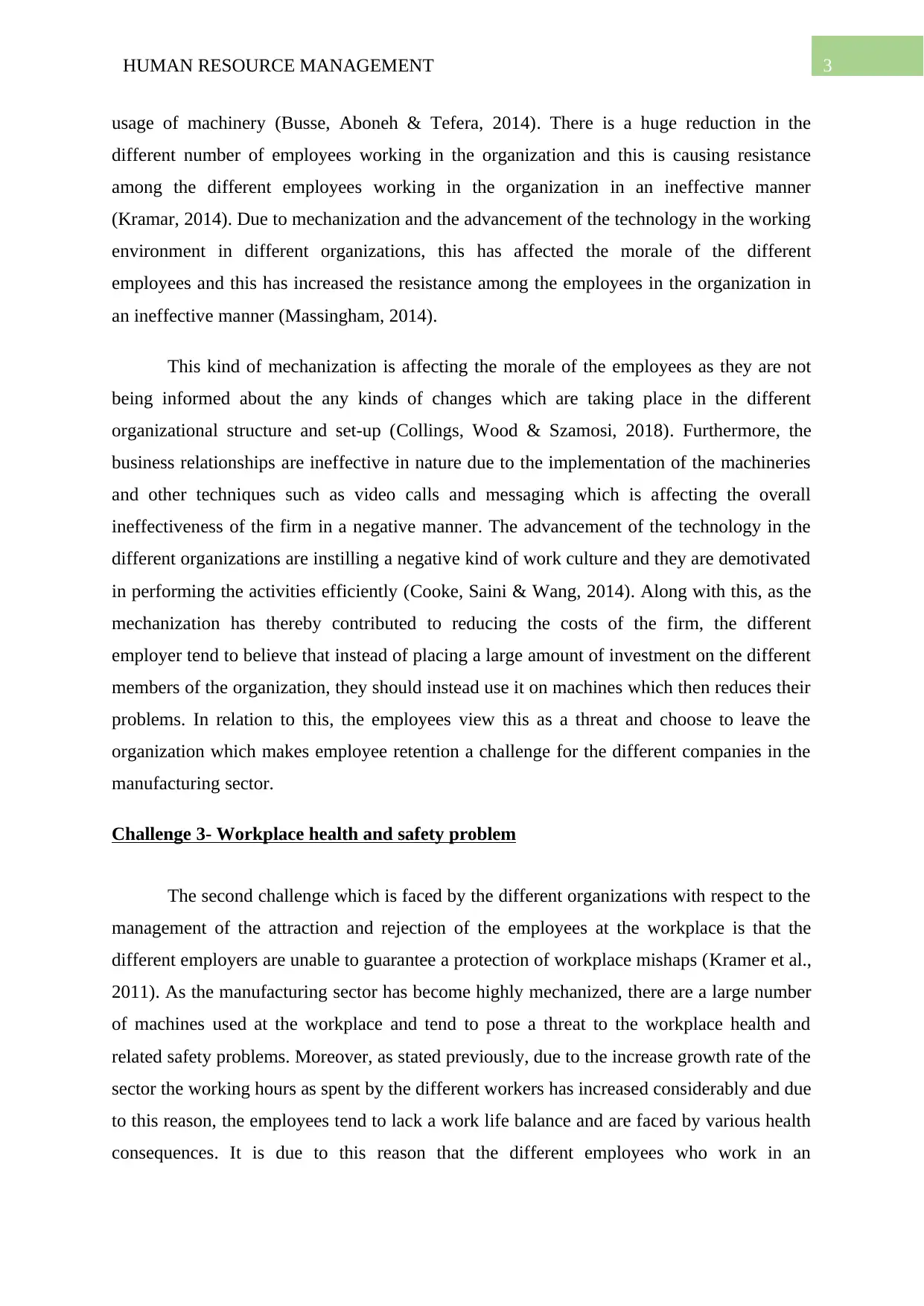
3HUMAN RESOURCE MANAGEMENT
usage of machinery (Busse, Aboneh & Tefera, 2014). There is a huge reduction in the
different number of employees working in the organization and this is causing resistance
among the different employees working in the organization in an ineffective manner
(Kramar, 2014). Due to mechanization and the advancement of the technology in the working
environment in different organizations, this has affected the morale of the different
employees and this has increased the resistance among the employees in the organization in
an ineffective manner (Massingham, 2014).
This kind of mechanization is affecting the morale of the employees as they are not
being informed about the any kinds of changes which are taking place in the different
organizational structure and set-up (Collings, Wood & Szamosi, 2018). Furthermore, the
business relationships are ineffective in nature due to the implementation of the machineries
and other techniques such as video calls and messaging which is affecting the overall
ineffectiveness of the firm in a negative manner. The advancement of the technology in the
different organizations are instilling a negative kind of work culture and they are demotivated
in performing the activities efficiently (Cooke, Saini & Wang, 2014). Along with this, as the
mechanization has thereby contributed to reducing the costs of the firm, the different
employer tend to believe that instead of placing a large amount of investment on the different
members of the organization, they should instead use it on machines which then reduces their
problems. In relation to this, the employees view this as a threat and choose to leave the
organization which makes employee retention a challenge for the different companies in the
manufacturing sector.
Challenge 3- Workplace health and safety problem
The second challenge which is faced by the different organizations with respect to the
management of the attraction and rejection of the employees at the workplace is that the
different employers are unable to guarantee a protection of workplace mishaps (Kramer et al.,
2011). As the manufacturing sector has become highly mechanized, there are a large number
of machines used at the workplace and tend to pose a threat to the workplace health and
related safety problems. Moreover, as stated previously, due to the increase growth rate of the
sector the working hours as spent by the different workers has increased considerably and due
to this reason, the employees tend to lack a work life balance and are faced by various health
consequences. It is due to this reason that the different employees who work in an
usage of machinery (Busse, Aboneh & Tefera, 2014). There is a huge reduction in the
different number of employees working in the organization and this is causing resistance
among the different employees working in the organization in an ineffective manner
(Kramar, 2014). Due to mechanization and the advancement of the technology in the working
environment in different organizations, this has affected the morale of the different
employees and this has increased the resistance among the employees in the organization in
an ineffective manner (Massingham, 2014).
This kind of mechanization is affecting the morale of the employees as they are not
being informed about the any kinds of changes which are taking place in the different
organizational structure and set-up (Collings, Wood & Szamosi, 2018). Furthermore, the
business relationships are ineffective in nature due to the implementation of the machineries
and other techniques such as video calls and messaging which is affecting the overall
ineffectiveness of the firm in a negative manner. The advancement of the technology in the
different organizations are instilling a negative kind of work culture and they are demotivated
in performing the activities efficiently (Cooke, Saini & Wang, 2014). Along with this, as the
mechanization has thereby contributed to reducing the costs of the firm, the different
employer tend to believe that instead of placing a large amount of investment on the different
members of the organization, they should instead use it on machines which then reduces their
problems. In relation to this, the employees view this as a threat and choose to leave the
organization which makes employee retention a challenge for the different companies in the
manufacturing sector.
Challenge 3- Workplace health and safety problem
The second challenge which is faced by the different organizations with respect to the
management of the attraction and rejection of the employees at the workplace is that the
different employers are unable to guarantee a protection of workplace mishaps (Kramer et al.,
2011). As the manufacturing sector has become highly mechanized, there are a large number
of machines used at the workplace and tend to pose a threat to the workplace health and
related safety problems. Moreover, as stated previously, due to the increase growth rate of the
sector the working hours as spent by the different workers has increased considerably and due
to this reason, the employees tend to lack a work life balance and are faced by various health
consequences. It is due to this reason that the different employees who work in an
Paraphrase This Document
Need a fresh take? Get an instant paraphrase of this document with our AI Paraphraser

4HUMAN RESOURCE MANAGEMENT
organization tend to leave the workplace in order to ensure that their health is protected. The
employers although can take considerable steps to ensure that safety measures are adopted
and that they are able to provide a work life balance however, in lieu of earning high amount
of profits, they are unable to consider the life of the employees and often tend to make the life
of the employees quite difficult which then ultimately leads to a problem with the higher
turnover rates.
Challenge 4- Competition has increased and working hours has increased
Due to the competition which has been increased in the entire business environment,
this has reduced the work-life balance of the different individuals working in the
organization. The competition has increased in the entire manufacturing sector which has
affected the motivational aspects which is missing in the different organizations. There is no
such implementation of the balance between the professional and personal life and this leads
to low productivity in the organization (Guillén, Mayo & Karelaia, 2018).
Furthermore, this has been noticed that when the employees are not being valued,
there will be rise in the absenteeism among the different employees and this increases the
overall emotional absenteeism among the different employees working in the respective
organization. This will lead to huge conflict in the workplace and there is low degree of
creativity and self-esteem in the organization in a negative manner (Hohenstein, Feisel &
Hartmann, 2014). This impacts the health of the different individuals in the organization
which has led to imbalance in the personal life of the employees. Although there are no
considerable steps which can be adopted by the organization in this regard, it can be believed
that in order to provide a solution to the challenge as faced by the organization in this regard,
the firm can deploy the workers to work in various shifts. This in turn will save the costs of
the organization and also assist them in ensuring long term success.
For instance- This has been noticed that there are few organizations namely Amcor
and ANCA which are the major competitors in the Australian market uses the advancement
of technology techniques which is impacting the work-life balance of the employees and
there has been reduction in the number of employees as they do not find the work place is
suitable as they are not receiving enough motivation and engagement in the workplace and
this is demotivating the overall productivity of the individuals.
organization tend to leave the workplace in order to ensure that their health is protected. The
employers although can take considerable steps to ensure that safety measures are adopted
and that they are able to provide a work life balance however, in lieu of earning high amount
of profits, they are unable to consider the life of the employees and often tend to make the life
of the employees quite difficult which then ultimately leads to a problem with the higher
turnover rates.
Challenge 4- Competition has increased and working hours has increased
Due to the competition which has been increased in the entire business environment,
this has reduced the work-life balance of the different individuals working in the
organization. The competition has increased in the entire manufacturing sector which has
affected the motivational aspects which is missing in the different organizations. There is no
such implementation of the balance between the professional and personal life and this leads
to low productivity in the organization (Guillén, Mayo & Karelaia, 2018).
Furthermore, this has been noticed that when the employees are not being valued,
there will be rise in the absenteeism among the different employees and this increases the
overall emotional absenteeism among the different employees working in the respective
organization. This will lead to huge conflict in the workplace and there is low degree of
creativity and self-esteem in the organization in a negative manner (Hohenstein, Feisel &
Hartmann, 2014). This impacts the health of the different individuals in the organization
which has led to imbalance in the personal life of the employees. Although there are no
considerable steps which can be adopted by the organization in this regard, it can be believed
that in order to provide a solution to the challenge as faced by the organization in this regard,
the firm can deploy the workers to work in various shifts. This in turn will save the costs of
the organization and also assist them in ensuring long term success.
For instance- This has been noticed that there are few organizations namely Amcor
and ANCA which are the major competitors in the Australian market uses the advancement
of technology techniques which is impacting the work-life balance of the employees and
there has been reduction in the number of employees as they do not find the work place is
suitable as they are not receiving enough motivation and engagement in the workplace and
this is demotivating the overall productivity of the individuals.

5HUMAN RESOURCE MANAGEMENT
Challenge 5- Lack of growth opportunities and career development
Although the pay is often considered to be high in the manufacturing sector and the
different employers believe that as the firm is able to successfully provide a considerable pay
to the employees, they will be working well for the organization, however this is not the case
(Kramer et al., 2011). The major challenge which is faced by the different organizations in
the manufacturing sector is that the different employers are unable to provide a career
development opportunity to the employees along with considerable growth opportunities. The
major reason behind this is that the employers are often just concerned with their profits and
they do not take into consideration the development of the different employers (Anonymous,
2014). However, contrary to the popular belief, it is not just the hygienic factors of the
compensation and bonuses that motivate the different members of the organization to work
but it is also a proven fact that in order to have a prosperous work career, the different
employees also believe that there should be a presence of the career development of the
specific organization which will then thereby assist the different employees to perform
considerably well and act as a factor of intrinsic motivation, following which the different
employees will perform well (Azmi, 2011).
The intrinsic motivation tends to act as one of the strongest factors using which the
different employers will be successfully able to ensure that their retention rates and turnover
rates improve (Kramer et al., 2011). However, the problem in this case lies that the employers
due to restriction of funds or the narrow organizational structure are unable to provide a
career prospect to the different employees which then leads to a limitation on the side of the
employer as well as the employee and this acts as one of the major reasons why the members
of the firm leave and the employers are unable to stop them.
Recommendations
The section provides various recommendations which can assist the manufacturing
sector organizations in reducing the different challenges and help in managing the overall
productivity of the organization. The different recommendations are inclusive of the
following:
Challenge 5- Lack of growth opportunities and career development
Although the pay is often considered to be high in the manufacturing sector and the
different employers believe that as the firm is able to successfully provide a considerable pay
to the employees, they will be working well for the organization, however this is not the case
(Kramer et al., 2011). The major challenge which is faced by the different organizations in
the manufacturing sector is that the different employers are unable to provide a career
development opportunity to the employees along with considerable growth opportunities. The
major reason behind this is that the employers are often just concerned with their profits and
they do not take into consideration the development of the different employers (Anonymous,
2014). However, contrary to the popular belief, it is not just the hygienic factors of the
compensation and bonuses that motivate the different members of the organization to work
but it is also a proven fact that in order to have a prosperous work career, the different
employees also believe that there should be a presence of the career development of the
specific organization which will then thereby assist the different employees to perform
considerably well and act as a factor of intrinsic motivation, following which the different
employees will perform well (Azmi, 2011).
The intrinsic motivation tends to act as one of the strongest factors using which the
different employers will be successfully able to ensure that their retention rates and turnover
rates improve (Kramer et al., 2011). However, the problem in this case lies that the employers
due to restriction of funds or the narrow organizational structure are unable to provide a
career prospect to the different employees which then leads to a limitation on the side of the
employer as well as the employee and this acts as one of the major reasons why the members
of the firm leave and the employers are unable to stop them.
Recommendations
The section provides various recommendations which can assist the manufacturing
sector organizations in reducing the different challenges and help in managing the overall
productivity of the organization. The different recommendations are inclusive of the
following:
⊘ This is a preview!⊘
Do you want full access?
Subscribe today to unlock all pages.

Trusted by 1+ million students worldwide
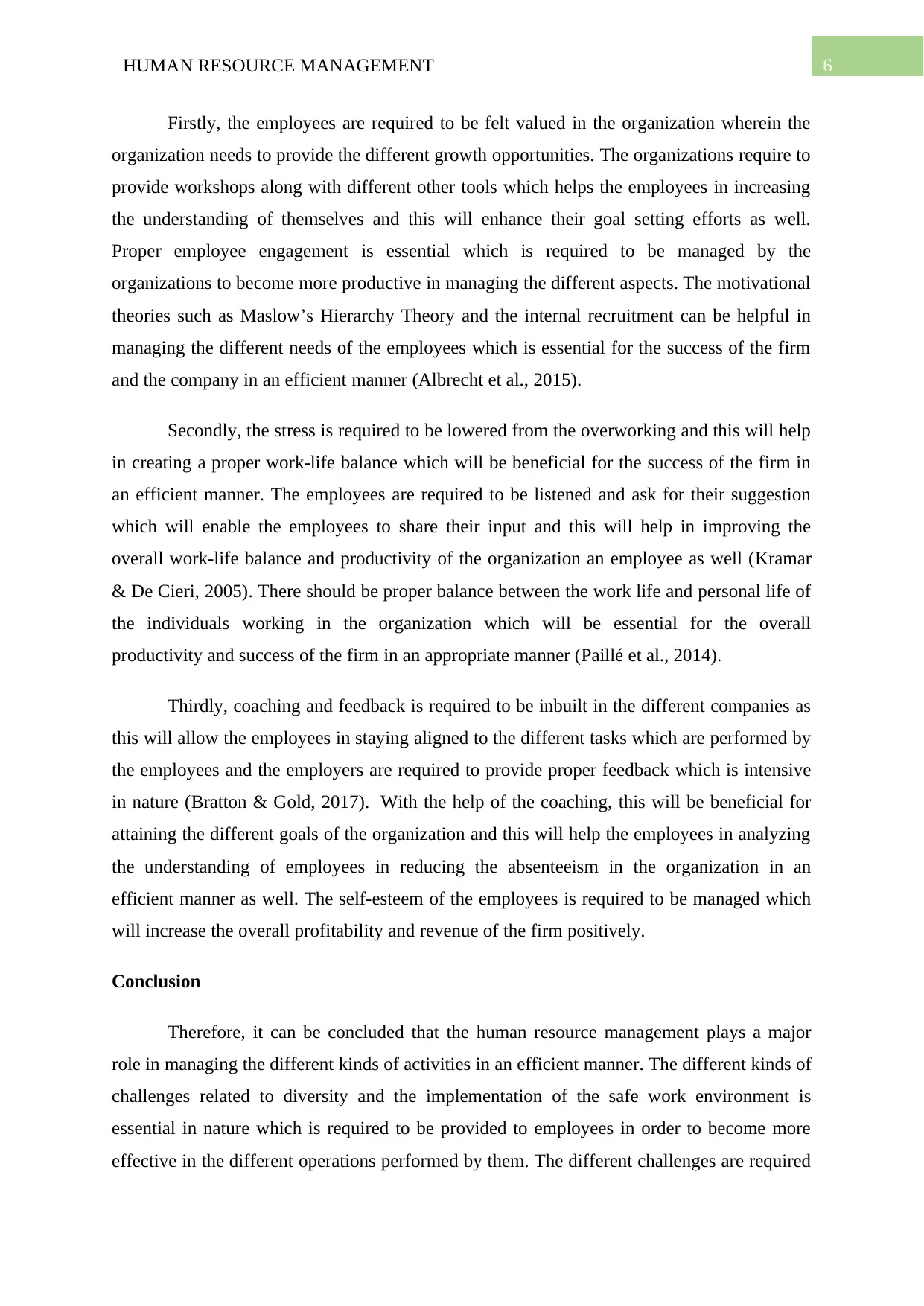
6HUMAN RESOURCE MANAGEMENT
Firstly, the employees are required to be felt valued in the organization wherein the
organization needs to provide the different growth opportunities. The organizations require to
provide workshops along with different other tools which helps the employees in increasing
the understanding of themselves and this will enhance their goal setting efforts as well.
Proper employee engagement is essential which is required to be managed by the
organizations to become more productive in managing the different aspects. The motivational
theories such as Maslow’s Hierarchy Theory and the internal recruitment can be helpful in
managing the different needs of the employees which is essential for the success of the firm
and the company in an efficient manner (Albrecht et al., 2015).
Secondly, the stress is required to be lowered from the overworking and this will help
in creating a proper work-life balance which will be beneficial for the success of the firm in
an efficient manner. The employees are required to be listened and ask for their suggestion
which will enable the employees to share their input and this will help in improving the
overall work-life balance and productivity of the organization an employee as well (Kramar
& De Cieri, 2005). There should be proper balance between the work life and personal life of
the individuals working in the organization which will be essential for the overall
productivity and success of the firm in an appropriate manner (Paillé et al., 2014).
Thirdly, coaching and feedback is required to be inbuilt in the different companies as
this will allow the employees in staying aligned to the different tasks which are performed by
the employees and the employers are required to provide proper feedback which is intensive
in nature (Bratton & Gold, 2017). With the help of the coaching, this will be beneficial for
attaining the different goals of the organization and this will help the employees in analyzing
the understanding of employees in reducing the absenteeism in the organization in an
efficient manner as well. The self-esteem of the employees is required to be managed which
will increase the overall profitability and revenue of the firm positively.
Conclusion
Therefore, it can be concluded that the human resource management plays a major
role in managing the different kinds of activities in an efficient manner. The different kinds of
challenges related to diversity and the implementation of the safe work environment is
essential in nature which is required to be provided to employees in order to become more
effective in the different operations performed by them. The different challenges are required
Firstly, the employees are required to be felt valued in the organization wherein the
organization needs to provide the different growth opportunities. The organizations require to
provide workshops along with different other tools which helps the employees in increasing
the understanding of themselves and this will enhance their goal setting efforts as well.
Proper employee engagement is essential which is required to be managed by the
organizations to become more productive in managing the different aspects. The motivational
theories such as Maslow’s Hierarchy Theory and the internal recruitment can be helpful in
managing the different needs of the employees which is essential for the success of the firm
and the company in an efficient manner (Albrecht et al., 2015).
Secondly, the stress is required to be lowered from the overworking and this will help
in creating a proper work-life balance which will be beneficial for the success of the firm in
an efficient manner. The employees are required to be listened and ask for their suggestion
which will enable the employees to share their input and this will help in improving the
overall work-life balance and productivity of the organization an employee as well (Kramar
& De Cieri, 2005). There should be proper balance between the work life and personal life of
the individuals working in the organization which will be essential for the overall
productivity and success of the firm in an appropriate manner (Paillé et al., 2014).
Thirdly, coaching and feedback is required to be inbuilt in the different companies as
this will allow the employees in staying aligned to the different tasks which are performed by
the employees and the employers are required to provide proper feedback which is intensive
in nature (Bratton & Gold, 2017). With the help of the coaching, this will be beneficial for
attaining the different goals of the organization and this will help the employees in analyzing
the understanding of employees in reducing the absenteeism in the organization in an
efficient manner as well. The self-esteem of the employees is required to be managed which
will increase the overall profitability and revenue of the firm positively.
Conclusion
Therefore, it can be concluded that the human resource management plays a major
role in managing the different kinds of activities in an efficient manner. The different kinds of
challenges related to diversity and the implementation of the safe work environment is
essential in nature which is required to be provided to employees in order to become more
effective in the different operations performed by them. The different challenges are required
Paraphrase This Document
Need a fresh take? Get an instant paraphrase of this document with our AI Paraphraser

7HUMAN RESOURCE MANAGEMENT
to be managed which will be beneficial for the success of the firm along with the employees
in performing and managing the different activities in an effective manner.
The resistance among the employees is required to be reduced in the different
organizations which will be beneficial for the overall success of the firm and gain more
competitive advantage of the firm in a positive manner as well. The different
recommendations have been provided wherein creation of proper work environment which
will help in making the employees feel that they are the essential assets of the organization
which will be beneficial for the success and productivity of the firm. Proper opportunities are
required to be provided to the employees as they are integral part of the organizations and this
will help in creating open and honest workplace environment as well.
to be managed which will be beneficial for the success of the firm along with the employees
in performing and managing the different activities in an effective manner.
The resistance among the employees is required to be reduced in the different
organizations which will be beneficial for the overall success of the firm and gain more
competitive advantage of the firm in a positive manner as well. The different
recommendations have been provided wherein creation of proper work environment which
will help in making the employees feel that they are the essential assets of the organization
which will be beneficial for the success and productivity of the firm. Proper opportunities are
required to be provided to the employees as they are integral part of the organizations and this
will help in creating open and honest workplace environment as well.
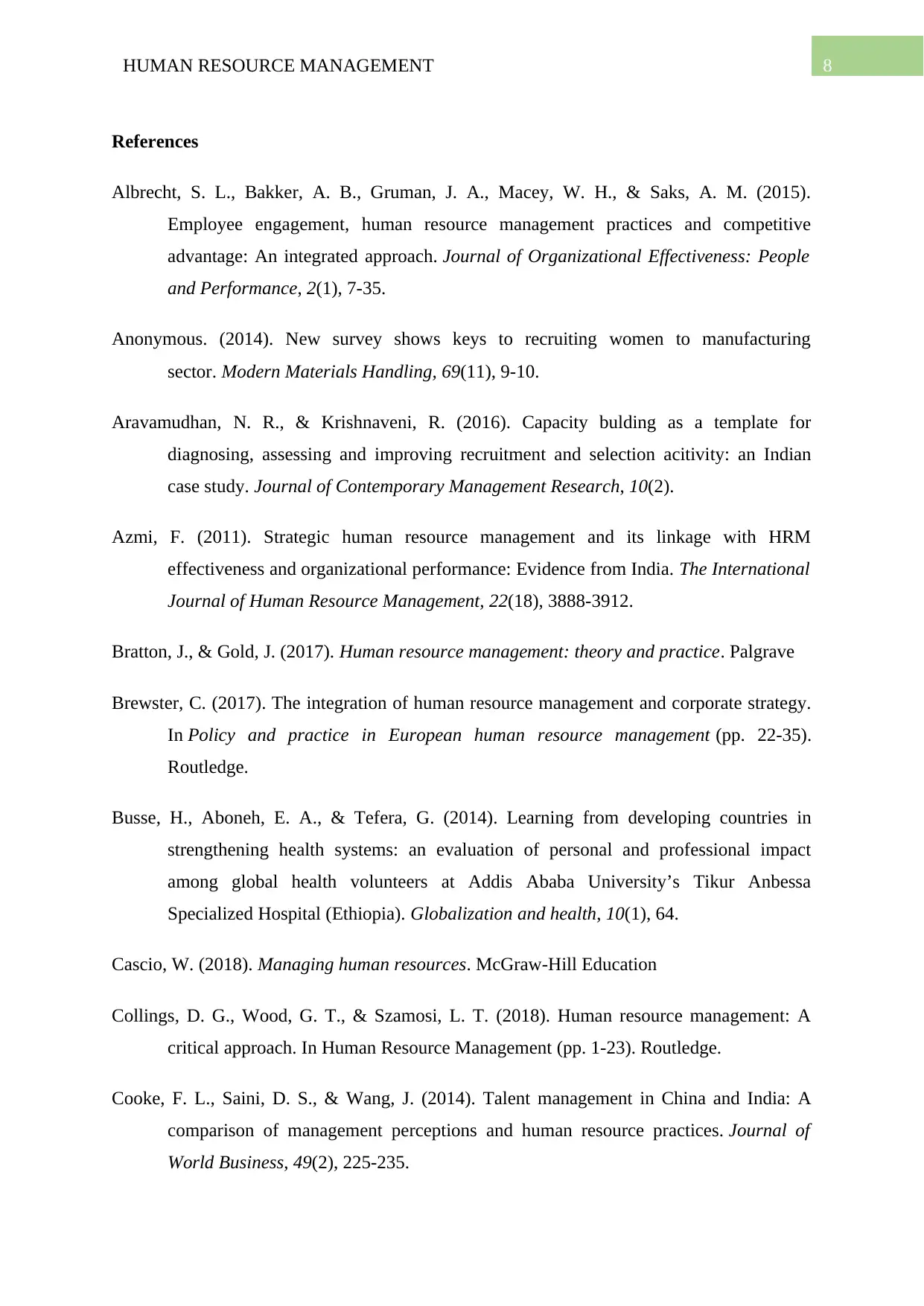
8HUMAN RESOURCE MANAGEMENT
References
Albrecht, S. L., Bakker, A. B., Gruman, J. A., Macey, W. H., & Saks, A. M. (2015).
Employee engagement, human resource management practices and competitive
advantage: An integrated approach. Journal of Organizational Effectiveness: People
and Performance, 2(1), 7-35.
Anonymous. (2014). New survey shows keys to recruiting women to manufacturing
sector. Modern Materials Handling, 69(11), 9-10.
Aravamudhan, N. R., & Krishnaveni, R. (2016). Capacity bulding as a template for
diagnosing, assessing and improving recruitment and selection acitivity: an Indian
case study. Journal of Contemporary Management Research, 10(2).
Azmi, F. (2011). Strategic human resource management and its linkage with HRM
effectiveness and organizational performance: Evidence from India. The International
Journal of Human Resource Management, 22(18), 3888-3912.
Bratton, J., & Gold, J. (2017). Human resource management: theory and practice. Palgrave
Brewster, C. (2017). The integration of human resource management and corporate strategy.
In Policy and practice in European human resource management (pp. 22-35).
Routledge.
Busse, H., Aboneh, E. A., & Tefera, G. (2014). Learning from developing countries in
strengthening health systems: an evaluation of personal and professional impact
among global health volunteers at Addis Ababa University’s Tikur Anbessa
Specialized Hospital (Ethiopia). Globalization and health, 10(1), 64.
Cascio, W. (2018). Managing human resources. McGraw-Hill Education
Collings, D. G., Wood, G. T., & Szamosi, L. T. (2018). Human resource management: A
critical approach. In Human Resource Management (pp. 1-23). Routledge.
Cooke, F. L., Saini, D. S., & Wang, J. (2014). Talent management in China and India: A
comparison of management perceptions and human resource practices. Journal of
World Business, 49(2), 225-235.
References
Albrecht, S. L., Bakker, A. B., Gruman, J. A., Macey, W. H., & Saks, A. M. (2015).
Employee engagement, human resource management practices and competitive
advantage: An integrated approach. Journal of Organizational Effectiveness: People
and Performance, 2(1), 7-35.
Anonymous. (2014). New survey shows keys to recruiting women to manufacturing
sector. Modern Materials Handling, 69(11), 9-10.
Aravamudhan, N. R., & Krishnaveni, R. (2016). Capacity bulding as a template for
diagnosing, assessing and improving recruitment and selection acitivity: an Indian
case study. Journal of Contemporary Management Research, 10(2).
Azmi, F. (2011). Strategic human resource management and its linkage with HRM
effectiveness and organizational performance: Evidence from India. The International
Journal of Human Resource Management, 22(18), 3888-3912.
Bratton, J., & Gold, J. (2017). Human resource management: theory and practice. Palgrave
Brewster, C. (2017). The integration of human resource management and corporate strategy.
In Policy and practice in European human resource management (pp. 22-35).
Routledge.
Busse, H., Aboneh, E. A., & Tefera, G. (2014). Learning from developing countries in
strengthening health systems: an evaluation of personal and professional impact
among global health volunteers at Addis Ababa University’s Tikur Anbessa
Specialized Hospital (Ethiopia). Globalization and health, 10(1), 64.
Cascio, W. (2018). Managing human resources. McGraw-Hill Education
Collings, D. G., Wood, G. T., & Szamosi, L. T. (2018). Human resource management: A
critical approach. In Human Resource Management (pp. 1-23). Routledge.
Cooke, F. L., Saini, D. S., & Wang, J. (2014). Talent management in China and India: A
comparison of management perceptions and human resource practices. Journal of
World Business, 49(2), 225-235.
⊘ This is a preview!⊘
Do you want full access?
Subscribe today to unlock all pages.

Trusted by 1+ million students worldwide
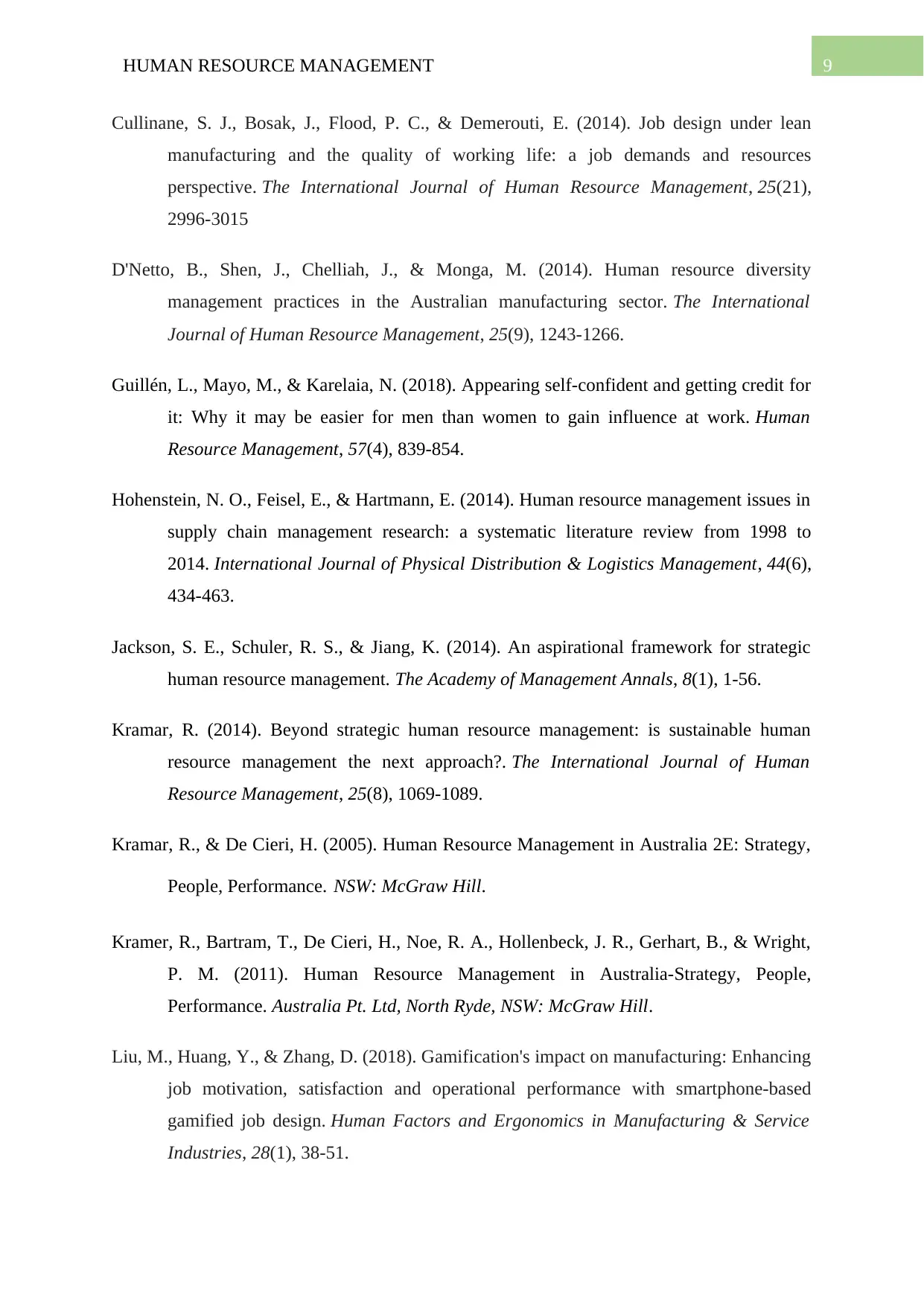
9HUMAN RESOURCE MANAGEMENT
Cullinane, S. J., Bosak, J., Flood, P. C., & Demerouti, E. (2014). Job design under lean
manufacturing and the quality of working life: a job demands and resources
perspective. The International Journal of Human Resource Management, 25(21),
2996-3015
D'Netto, B., Shen, J., Chelliah, J., & Monga, M. (2014). Human resource diversity
management practices in the Australian manufacturing sector. The International
Journal of Human Resource Management, 25(9), 1243-1266.
Guillén, L., Mayo, M., & Karelaia, N. (2018). Appearing self‐confident and getting credit for
it: Why it may be easier for men than women to gain influence at work. Human
Resource Management, 57(4), 839-854.
Hohenstein, N. O., Feisel, E., & Hartmann, E. (2014). Human resource management issues in
supply chain management research: a systematic literature review from 1998 to
2014. International Journal of Physical Distribution & Logistics Management, 44(6),
434-463.
Jackson, S. E., Schuler, R. S., & Jiang, K. (2014). An aspirational framework for strategic
human resource management. The Academy of Management Annals, 8(1), 1-56.
Kramar, R. (2014). Beyond strategic human resource management: is sustainable human
resource management the next approach?. The International Journal of Human
Resource Management, 25(8), 1069-1089.
Kramar, R., & De Cieri, H. (2005). Human Resource Management in Australia 2E: Strategy,
People, Performance. NSW: McGraw Hill.
Kramer, R., Bartram, T., De Cieri, H., Noe, R. A., Hollenbeck, J. R., Gerhart, B., & Wright,
P. M. (2011). Human Resource Management in Australia-Strategy, People,
Performance. Australia Pt. Ltd, North Ryde, NSW: McGraw Hill.
Liu, M., Huang, Y., & Zhang, D. (2018). Gamification's impact on manufacturing: Enhancing
job motivation, satisfaction and operational performance with smartphone‐based
gamified job design. Human Factors and Ergonomics in Manufacturing & Service
Industries, 28(1), 38-51.
Cullinane, S. J., Bosak, J., Flood, P. C., & Demerouti, E. (2014). Job design under lean
manufacturing and the quality of working life: a job demands and resources
perspective. The International Journal of Human Resource Management, 25(21),
2996-3015
D'Netto, B., Shen, J., Chelliah, J., & Monga, M. (2014). Human resource diversity
management practices in the Australian manufacturing sector. The International
Journal of Human Resource Management, 25(9), 1243-1266.
Guillén, L., Mayo, M., & Karelaia, N. (2018). Appearing self‐confident and getting credit for
it: Why it may be easier for men than women to gain influence at work. Human
Resource Management, 57(4), 839-854.
Hohenstein, N. O., Feisel, E., & Hartmann, E. (2014). Human resource management issues in
supply chain management research: a systematic literature review from 1998 to
2014. International Journal of Physical Distribution & Logistics Management, 44(6),
434-463.
Jackson, S. E., Schuler, R. S., & Jiang, K. (2014). An aspirational framework for strategic
human resource management. The Academy of Management Annals, 8(1), 1-56.
Kramar, R. (2014). Beyond strategic human resource management: is sustainable human
resource management the next approach?. The International Journal of Human
Resource Management, 25(8), 1069-1089.
Kramar, R., & De Cieri, H. (2005). Human Resource Management in Australia 2E: Strategy,
People, Performance. NSW: McGraw Hill.
Kramer, R., Bartram, T., De Cieri, H., Noe, R. A., Hollenbeck, J. R., Gerhart, B., & Wright,
P. M. (2011). Human Resource Management in Australia-Strategy, People,
Performance. Australia Pt. Ltd, North Ryde, NSW: McGraw Hill.
Liu, M., Huang, Y., & Zhang, D. (2018). Gamification's impact on manufacturing: Enhancing
job motivation, satisfaction and operational performance with smartphone‐based
gamified job design. Human Factors and Ergonomics in Manufacturing & Service
Industries, 28(1), 38-51.
Paraphrase This Document
Need a fresh take? Get an instant paraphrase of this document with our AI Paraphraser
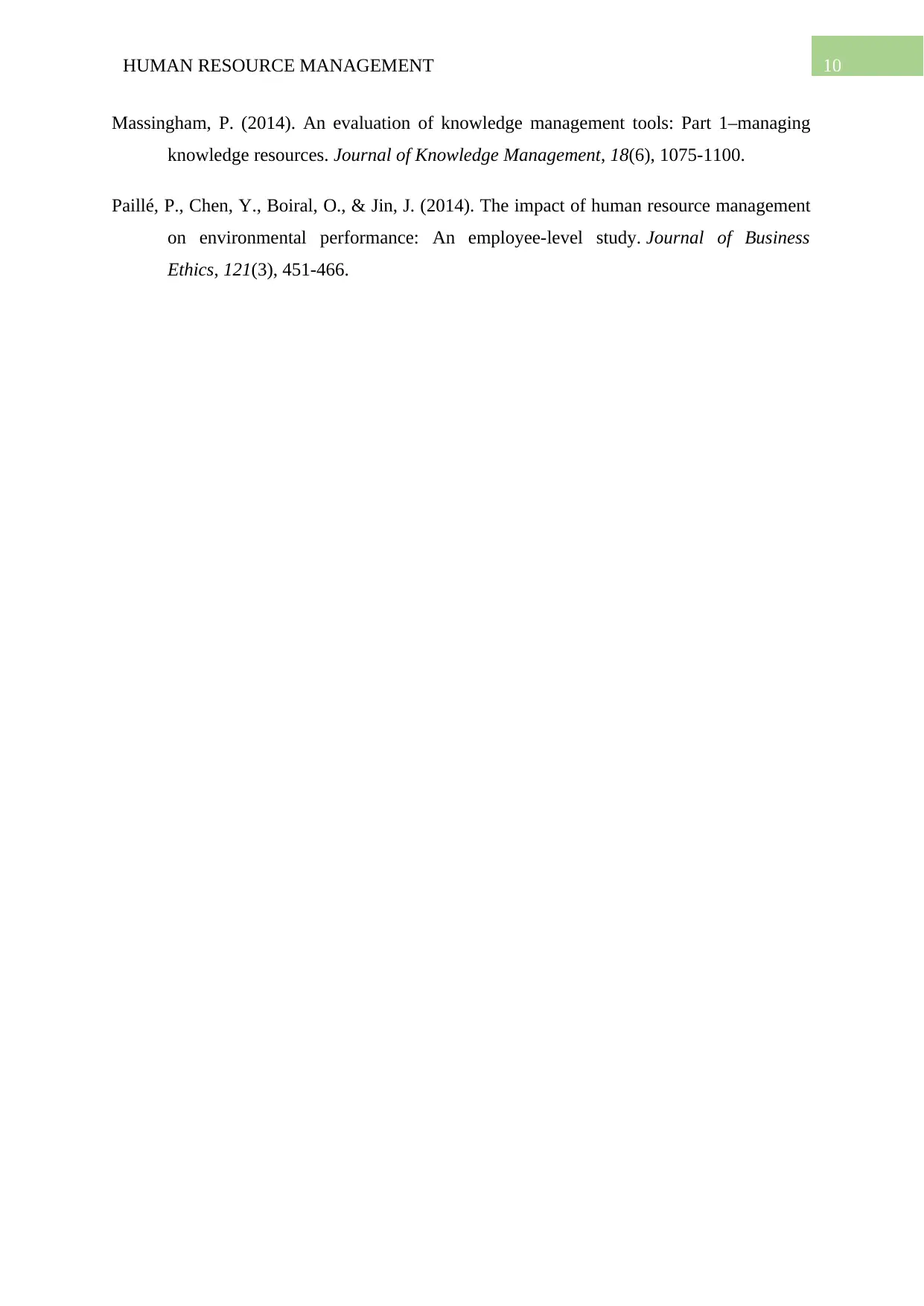
10HUMAN RESOURCE MANAGEMENT
Massingham, P. (2014). An evaluation of knowledge management tools: Part 1–managing
knowledge resources. Journal of Knowledge Management, 18(6), 1075-1100.
Paillé, P., Chen, Y., Boiral, O., & Jin, J. (2014). The impact of human resource management
on environmental performance: An employee-level study. Journal of Business
Ethics, 121(3), 451-466.
Massingham, P. (2014). An evaluation of knowledge management tools: Part 1–managing
knowledge resources. Journal of Knowledge Management, 18(6), 1075-1100.
Paillé, P., Chen, Y., Boiral, O., & Jin, J. (2014). The impact of human resource management
on environmental performance: An employee-level study. Journal of Business
Ethics, 121(3), 451-466.
1 out of 11
Related Documents
Your All-in-One AI-Powered Toolkit for Academic Success.
+13062052269
info@desklib.com
Available 24*7 on WhatsApp / Email
![[object Object]](/_next/static/media/star-bottom.7253800d.svg)
Unlock your academic potential
Copyright © 2020–2025 A2Z Services. All Rights Reserved. Developed and managed by ZUCOL.




